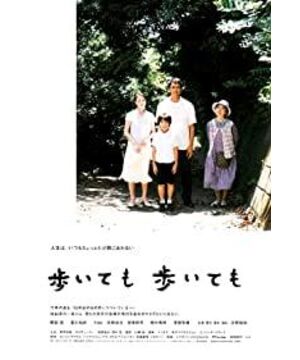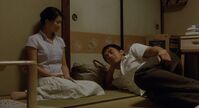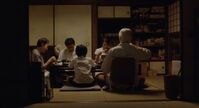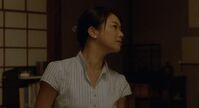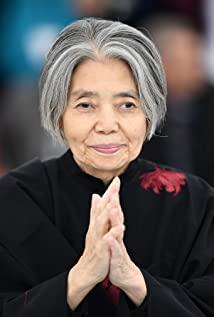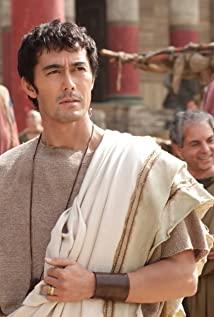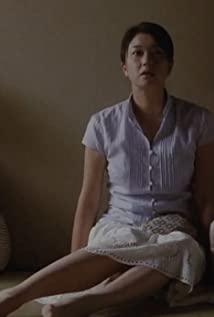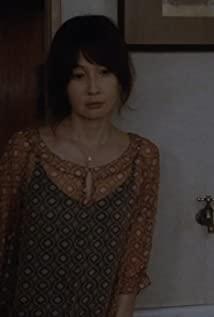It was Hirokazu-eda’s video journey that began with documentaries. After graduating from the First Department of Literature at Waseda University, he mainly worked on TV documentaries. This work experience has a profound influence on his feature film shooting style. Serious creation based on real social events is a consistent feature of his earlier feature films. However, in 2008's "Never Stop", Hirokazu Koreeda put all his vision into his family life itself, giving the film a new entry point and characteristics. : Autobiographical and personal. This turn from society (public) to family (private) marks a transcendence of his image aesthetics over tradition and self. In the realm of family space, compared with Mikio Naruse, it is Hirokazu Koreeda's innovation that he has opened up an autobiographical private discourse space. The meaning of social education and the tragic color in the former film are diluted here, and after the dust settles, the film returns to the authenticity of the director's private family memory. In this sense, it can also be said that this is Hirokazu Kore-eda's first film based on his own inner experience. Taking this as a starting point, the director completed a "private realism" of family life. The birth of the film stemmed from the death of Hirokazu Koreeda and his mother. Because of this, the setting of the characters in the film and the description of the relationship between the characters (such as the relationship between the son and the mother, the alienation between the father) are all based on the director's own life. The whole film restores the daily life of an ordinary family for us in a low-key, realistic and naturalistic style. Among them, the image of the mother created by Shu Xilin is the most complete embodiment of the director's artistic style. On the one hand, it is Hirokazu Koreeda who eliminated subjective factors such as exaggerated deformation techniques and lyrical beautification commonly used in romanticism, and at the same time completely abandoned the stylized techniques advocated by realism, and pursued a purely objective record and description. He did not deliberately create an image of a mother who occupied the commanding heights in human nature and morality and was kidnapped by genre patterns and dramatic effects. Instead, he just let real characters move in a real environment and presented viewers with various fragments of the characters' lives. . Taking realism as the highest artistic criterion, the mother created in this way cannot make people feel lovable and respectable, and even a little bit of disgust is mixed. However, it is precisely in this way that the image of mother achieves a higher level of reality. The mother's character in the play has a considerable degree of pungency and cruelty, and the eccentricity, stubbornness and selfishness of these human spots are presented unabashedly. For example, she loves her daughter very much on the surface, but in private she puts her son first in everything; she seems to get along well with her daughter-in-law, but in fact she has a grudge and has all kinds of doubts and precautions for her. Of course, her character traits are undoubtedly best reflected in her story of the death of her eldest son. attitude. The eldest son, Junpei, drowned in order to save a boy from drowning in his early years. Every year after Junpei's death anniversary, his mother would invite the boy to his house as a guest. Underneath the hospitable hospitality on the surface, it is actually a mockery and lashing of the youth's life and self-esteem. It seemed that only in the embarrassment of sweating profusely and fidgeting as a teenager could she find some relief and relief. Such a character can't help but give people a bit of hatred, but in the subsequent shots, she chases the yellow butterfly, thinking that it is the soul of her son Junpei, and the dejected demeanor makes people very sigh and moved. An individual's character, situation, and existence are unique and complex, and the "material restoration" of this real life state is what Hirokazu Kore-eda pursues. Heroes are not interested, I just want to see people as they are."
2. Anti-plot narrative
In terms of narrative, "Never Stop" also has a significant personal style, that is, it breaks through the classical narrative mode of classic melodrama movies, and adopts a natural and realistic life-flow narrative method, or it can also be called Anti-plot narrative mode. The narrative mode of melodrama films is strictly based on the "law of conflict" constructed by Hegel. The so-called "conflict law", that is, the creative method of structuring stories with conflict as the core, originally belonged to the category of drama, and was later applied to the practice of film creation on a large scale. In the classic narrative based on the "law of conflict", the setting of characters, the development of the plot and the choice of actions all depend on whether they can create conflict. Taking the narrative of classic Hollywood melodramas as an example, the standard narrative paradigm calls for a story to develop a “wavy” “closed” narrative around a plot line that runs through it. The development of the plot needs to have four clear and scattered stages, and the conflict needs to have a clear cause and solution. The narrative of "Never Stop" is just the opposite. The whole film is like the natural passage of life time, starting from the daily dialogue between mother and daughter in the kitchen in the early morning, and finally when night falls, the characters fall asleep. The narrative time of the film is roughly parallel to the real life time, and human intervention
is abandoned. In addition, Hirokazu Kore-eda also uses a scattered narrative method in this film, from the perspective of three generations of grandparents and grandchildren in the big family. Set out to form a dense network narrative structure. Therefore, there is no single prominent protagonist in the whole play. Every family member occupies a certain space, and their emotions and living conditions have been written as the focus of attention. Although the stories of some members are only briefly mentioned in the whole film, Hirokazu Kore-eda also tries to make the viewers know the autumn in the most ingenious way. For example, the deceased eldest brother has never appeared in the whole play, but we can feel his weight and place in the family all the time. The reason is that although he died, he was the only emotional bond in this increasingly estranged family, and even the annual family gathering was realized because of his sacrificial day. This narrative thread of his seems to be absent, but it is actually a hidden undercurrent that opens up infinite possibilities for other narrative directions. As a matter of course, there are no prominent events or pre-set conflicts in the whole play. The things described are nothing more than ordinary family affairs of a tea and a meal. The tradition of quiet and far-reaching family life under the lens of Yasujiro Ozu has been continued here.
However, the whole film seems bland but not dull. It was Hirokazu Koreeda who pursued de-dramatic realism, not anti-drama. As revealed in the interview with the director of this play, in order to show a more realistic feeling, the script was constantly rehearsed and revised verbally by the staff, and what was finally presented was actually the result of a lot of hard work. Therefore, the narrative surface of this play seems to be calm, but in fact there is a turbulent emotional undercurrent hidden inside. The director subtly blends drama with deep technical and emotional tension.
The first is the superposition of details. It is Hirokazu Koreeda weave the plot with rich life details and restore the truth. The reason for abandoning the fierce conflict and replacing it with fragmented life fragments is probably as Ballaz said: "The main object of film is material details, and at the same time due to the decline of ideology, ours have been broken into pieces. The soul of the film is, in fact, inevitably better suited to assimilating the fleeting moments of material life." Moreover, the detail, as a tiny narrative unit, "undoubtedly serves to advance the storyline to which it belongs, but at the same time it is also purely As an isolated moment in visible reality, as if surrounded by vague intentions, it has a strong, even major impact on us." Moreover, these details "reveal a far wider realm than the plot they advance. This realm lies, so to speak, under the superstructure of particular story content; Familiar moments, such as birth or death, a smile, or 'the wind blows the leaves, the waves themselves' are the most ordinary moments." There is a detail in the film - the mother's fried corn tempura, which seems to be the same The ordinary family snacks have secretly completed the plot recall and advancement of multiple clues, and it has also become a testimony and cohesion of the sincere feelings between family members. Every year at family gatherings, mothers make corn tempura and happily repeat the episode of stealing corn thirty years ago. Because it was her entry to her eldest son Junpei's memories, corn tempura was his favorite food. Her reminiscence of the complete family in the past, her unresolved state of mind about the pain of her son's death, and her teasing and tolerance for her father are all condensed in the details of the corn tempura. Throughout the film, this kind of detail can be seen everywhere, nothing is driven by the plot, everything is like a natural fit. As the director explained in the interview: "That film is nothing but the details. The little things add up to life. That's where the drama is—it's in the details."
In addition to the superposition of details, it is Hirokazu Kore-eda that completely subverts the one-dimensional narrative in melodrama movies. Since the narrative of "Non-Stop" is largely unfolded in a closed family space, in order to avoid the limitations that may be caused by a single scene, Hirokazu Kore-eda adopted clever combinations and replacements, that is, flexibly change the combination of scenes and people, In this way, the maximum narrative dimension and level can be obtained, and infinite possibilities of narrative can be created, so as to cover the whole picture of family life without leaving blanks and blind spots. For example, in addition to several happy gatherings of all family members, the play is also interspersed with solitude between female members of the family, between grandparents and grandchildren, between mother-in-law and daughter-in-law, and between children. Each family member has a different identity in different combinations, tells a new story, and even shows a secret self. Such a narrative strategy prevents us from ignoring any member of the Yokoyama family. The impression we get about the Yokoyama family through the images is by no means thin, but three-dimensional and full like a reticulated bird's nest.
3. The Video Essence of "Life Stream"
"Walking On" is Hirokazu-eda's most mature work so far. It can also be said that the family writing of "Walking On" marks his starting point and style. Because of this, he is often compared by critics with classic family ethics drama masters such as Yasujiro Ozu and Mikio Naruse. In this regard, Hirokazu Shire-eda has made it clear that he has no intention to follow his predecessors, nor can he become the heir to the family writing aesthetic paradigm established by the big studio films. Because, on the issue of image ontology, it is Hirokazu-eda who holds a completely different view from his predecessors. It also uses family realism as the video content. Even though there are many similarities and inheritances in the outer shell, it is completely different from his predecessors in that it is Hirokazu Koreeda who advocates a thorough realism and a "life flow" style of video. . Yasujiro Ozu spent his entire life writing about the family, but what he built with the hands of light and shadow is actually an idealized "home", an ideal dwelling that can be independent of the disintegrating outside world. Even though the tea, the meal, and the warmth of human feelings are all vividly depicted by him, this "home" is essentially a reflection of his artistic ideals. Like a persistent craftsman, Ozu devoted his life to building his ideal Greek temple dedicated to art and humanity. In contrast, the family realism under the lens of Naruse Mikio has the characteristics of a social problem drama. The family he presents is always troubled and troubled. The evil of human nature and the grief of women are always the parts of family life that are written with great effort. The director also intends to convey his views on the injustice of various social realities through these family realities, intervening in society with images. The difference is that Hirokazu Kore-eda has clearly expressed his resistance to films that convey social concepts. It cannot be said that there is a difference between the family realism of Hirokazu Koreeda and his predecessors. As a director, he naturally has different views on the realization of realism and video art. It is Hirokazu Kore-eda’s home that still maintains a rough and primitive texture like grit. This home is neither a projection of the director’s artistic and moral ideals, nor is it intended to establish a connection with social organizations through it. It just restores the original appearance of a family, restores the real life status of each family member, and preserves the shadows and mottles carried by each person's character without concealment. As Fellini famously said: "A 'good film' should not be expected to be a self-contained work of art, but should 'include errors, like life, like people'." On the contrary, this primitive and rough texture does not imply artistic conservatism and incompetence. It is this original realism that expands the farthest boundaries that art can reach, and finally realizes the greatest possibility of realism. Because the film of "Life Stream" evokes a richer reality than it actually depicts. The shots or combinations of shots in this film have multiple meanings, so their representation extends beyond the physical world. Because they constantly evoke various psycho-physical correspondences, they suggest a reality that can aptly be called 'life'. This kind of film tends to show the boundlessness of external existence." It is such a work that shows the vastness of human feelings, life and time with tiny details and thorough realism.
View more about Still Walking reviews


